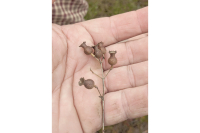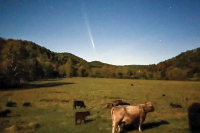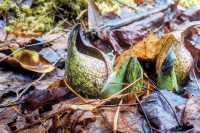Mystique of the monarch: Butterfly’s migratory life inspires wonder, scientific inquiry

It was a chilly February morning in 2020 when Clemson, South Carolina, resident Heyward Douglass laid eyes on the legendary monarch butterfly wintering grounds, first discovered only 45 years before. Oyamel fir trees covered the south-facing slopes of the Neovolcanic Mountains west of Mexico City, and millions of monarch butterflies covered the fir trees, 8,000 to 10,000 feet above sea level.
“What you see just blows your mind,” said Douglass, 74, an entomologist, pilot and former director of the Foothills Trail Conservancy. The tour group he was part of wasn’t allowed to walk through the roosting area. They had to stand just outside the edge, but that was spectacle enough.
“You’re just looking on down through there,” he said, “and they’re on every limb in front of you as far as you can see into the woods.”
A typical monarch butterfly weighs only about half a gram — barely anything — but the trees sagged under the collective weight of the hundreds and thousands of insects perched on their limbs.
“Every now and again a limb will crack,” Douglass recalled, “and a whole load of butterflies will flutter off and flutter around.”
Related Items
It was a magical week for Douglass, who from childhood has held avid interest in “all things to do with Mother Nature.” Douglass started the spider collection at Clemson University and logged the state’s first official observation of the poisonous brown recluse spider, and in 1985 he helped carry the first cage of peregrine falcons for release at Table Rock, South Carolina.
But throughout the years, the monarch butterfly has held a special fascination. Each fall, monarchs living east of the Rocky Mountains travel up to 3,000 miles from their summer breeding grounds to find safe haven for the winter, conserving energy to begin the northward journey once more in March. The butterflies stop in the southern U.S. to lay eggs, dying shortly thereafter. But the next generation continues the northward journey. It’s typically the year’s fourth generation that butts up against the end of summer and begins the southerly migration again. Migrating monarchs typically pass through Western North Carolina in late September.
While there are reports of western monarch overwintering sites in California dating back to the 1860s, for a long time nobody knew where monarchs east of the Rocky Mountains went once the weather turned cold.
“I think that’s one of the neatest stories in all of entomology in the last 50 years,” said Douglass. “For umpteen decades and decades, they just disappeared. They were like birds. And sure enough, they were doing more or less the same thing. It’s an incredible story.”
That story had not yet reached its conclusion in 1969, when Douglas graduated from Clemson University, or when he received his master’s degree in entomology from that institution a few years later. Douglass was finishing up a five-year term in the U.S. Air Force and starting a new job as an entomologist with the Clemson University Cooperative Extension Service when National Geographic published its famous August 1976 cover story, announcing the 1975 discovery of the monarch butterfly’s Mexican wintering grounds.
“I wanted in the worst way to go down there and see them, but it took almost 40 years before I managed to do it,” Douglass said.

- Heyward Douglass stands with a larger-than-life monarch. Donated photo
Large and beautiful in their striking black-and-orange coloring, the monarch butterfly is about as charismatic as an insect species can be. Their caterpillars are equally eye-catching, bands of white, black and yellow circling plump bodies until it’s time to spin themselves into jewel-like chrysalises, creamy green and gold-studded.
“They are such beautiful animals,” Douglass said. “If you want to have one that’s going to be your banner to march down the street with, certainly there’s nothing prettier than a monarch butterfly. It just lends itself to that type of affection from the general public.”
Conservation groups have been sounding the alarm on monarch butterflies for decades, as overwintering grounds in both Mexico and California have experienced enormous population declines. According to the International Union for the Conservation of Nature, the monarch population that winters in Mexico shrank 84% between 1996 and 2014. The smaller western population, which spends the winter along the Pacific Coast in California, fell from as many as 10 million in the 1980s to just 1,914 in 2021.
California’s 2022 count came in astoundingly high by comparison at more than 247,000 butterflies, but the nonprofit partnership Monarch Joint Venture pointed out in a press release that “we weren’t celebrating five years ago” when the census logged a similar number. A level of 200,000 to 300,000 butterflies “still represents a 95% decrease in the population from historic numbers,” the organization wrote. For various reasons monarchs, like many other insects, are subject to large year-to-year population fluctuations.
The butterfly is not listed under the Endangered Species Act, though that’s not because it doesn’t deserve to be. In 2020, the U.S. Fish and Wildlife Service found that the butterfly’s inclusion on the list is “warranted but precluded by work on higher-priority listing actions.” However, in June IUCN announced that it would add the monarch butterfly as an endangered species on its Red List of Threatened Species.
“It is difficult to watch monarch butterflies and their extraordinary migration teeter on the edge of collapse, but there are signs of hope,” Anna Walker, leader of the IUCN’s monarch butterfly assessment, said in a press release. “So many people and organizations have come together to try and protect this butterfly and its habitats.”
Loss of breeding, migrating and overwintering habitat are some of the biggest threats to monarch populations, according to Monarch Joint Venture. Chemicals used to control weeds and insects can also harm monarchs, and climate change is making some habitat less suitable than it used to be.
In recent decades, there’s been a push to engage people across the continent in making their communities more monarch-friendly by planting nectar-producing flowers and milkweed, whose leaves supply the only acceptable food source for monarch caterpillars. It’s a message with potential for big impact, said Douglass.
“What most people can do is very miniscule, but when you do it and you get thousands and thousands and maybe millions of people putting stuff out there, just like a lot of other things it mounts up,” he said.
He brought up the example of the bluebird, which went from being as common as the robin in the 1920s to teetering on the verge of extinction by 1970. A campaign to engage the public in putting up bluebird boxes resulted in a marked rebound of the population. Now the United States has a healthy, stable population of bluebirds.
The mystery of the monarch’s winter home is far from the only enigma where the monarch butterfly is concerned.
Just 11 days before IUCN’s announcement of the grave dangers facing North America’s migratory monarch butterfly, a group of six researchers published a paper indicating the situation may be far less dire than advertised.
“There’s this perception out there that monarch populations are in dire trouble, but we found that’s not at all the case,” Andy Davis, one of the study’s authors and an assistant research scientist at the University of Georgia, told Leigh Beeson of UGA Today. “It goes against what everyone thinks, but we found that they’re doing quite well. In fact, monarchs are actually one of the most widespread butterflies in North America.”
The researchers compiled more than 135,000 monarch butterfly observations that the North American Butterfly Association logged between 1993 and 2018 to look for patterns and population change drivers. During a two-day period each summer, volunteers with the organization log butterfly observations within a defined circle 15 miles in diameter.
While wintering populations in Mexico and California have seen dramatic declines, the researchers found an overall annual increase of 1.35% in the butterfly’s relative abundance. Traffic, bad weather and other obstacles might be making the southern journey more difficult than it used to be, but the findings suggest that summer breeding makes up for those losses, the researchers said.
“A single female can lay 500 eggs, so they’re capable of rebounding tremendously, given the right resources,” said Davis. “What that means is that the winter colony declines are almost like a red herring.”
These results don’t mean people should become complacent about the butterfly’s survival, as rising global temperatures could bring new threats — not just to monarchs, but to all insects. However, study co-author and UGA professor William Snyder thinks that there are other butterfly species in greater need of conservation focus.
“We don’t want to give the idea that insect conservation isn’t important, because it is,” he told UGA Today. “It’s just that maybe this one particular insect isn’t in nearly as much trouble as we thought.”

- National Geographic’s August 1976 issue reported the discovery of the monarch’s winter home.
Population numbers aside, monarchs possess something that arguably no other butterfly species has, at least in comparable quantities — immense, enthusiastic popularity. That can be a powerful tool for saving not only the monarch, but all the other species that are dependent on similar habitat conditions.
The United States is home to more than 4,000 bee species, 1,120 bird species and 750 butterfly species. Many of the same actions designed to help monarchs — reducing pesticide use, landscaping with native plants, conserving natural meadows — can help them too.
“If you have interest in monarchs and your heart goes there, you’re liable to have the same attitude toward other things that come up too,” said Douglass. “I think that the monarch being the banner for conservation and saving species and maybe ultimately ourselves, the more people we get thinking in that direction, the better.”
Celebrate the monarch
The inaugural Mountain Monarch Festival will come to Gorges State Park in Transylvania County 11 a.m. to 3 p.m. Saturday, Sept. 24, celebrating the monarch butterfly during its migration season.
Taking place at the park’s visitor center, the event will bring attention to the species’ declining overwintering numbers. It will include educational programs and exhibits, including monarch-themed children’s crafts, live music, a food truck, a festive photo board, local art for sale and a monarch migration passport to lead families through monarch-themed activities. Heyward Douglass, an entomologist who has worked as a park naturalist, visited the monarch’s wintering area in Mexico and served on the Foothills Trail Conservancy’s board of directors since 1989, will deliver a keynote presentation.
Gorges lies along the monarch’s migratory route, and each year in late September the butterflies fly over the park’s visitor center on their way south to high-elevation fir forests in Mexico’s Neovolcanic Mountains, where they stay until spring returns.
The event is free, though advance registration is requested by emailing “Monarch Festival Registration” and the number of people in your party to This email address is being protected from spambots. You need JavaScript enabled to view it.. It will be held rain or shine and is sponsored by Friends of Gorges State Park and organized in partnership with Monarch Watch, N.C. Cooperative Extension Service and N.C. Department of Commerce. For more details, visit www.ncparks.gov/events-and-programs.













